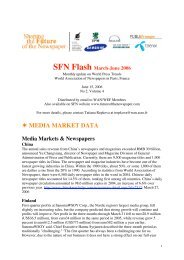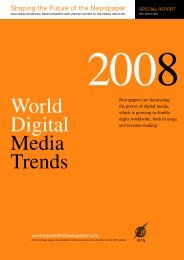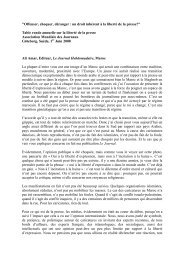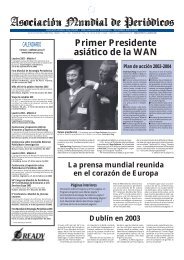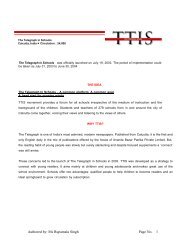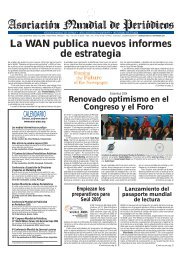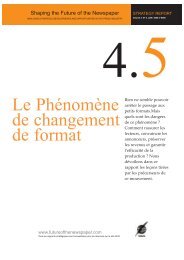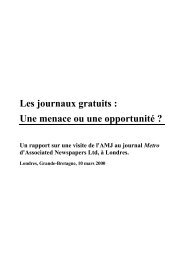WORLD PRESS TRENDS - World Association of Newspapers
WORLD PRESS TRENDS - World Association of Newspapers
WORLD PRESS TRENDS - World Association of Newspapers
Create successful ePaper yourself
Turn your PDF publications into a flip-book with our unique Google optimized e-Paper software.
CHINA<br />
The management <strong>of</strong> newspapers is still normally organised<br />
along the lines <strong>of</strong> the government hierarchy, so most city<br />
newspapers are subsidiaries <strong>of</strong> provincial-level Party<br />
mouthpieces. The ascendancy <strong>of</strong> the city newspapers over their<br />
parent titles represent the change in the function <strong>of</strong> newspaper<br />
from vehicles <strong>of</strong> propaganda to institutions <strong>of</strong> public opinion,<br />
and from the planned economy to the market.<br />
%<br />
80<br />
70<br />
60<br />
50<br />
40<br />
30<br />
20<br />
10<br />
0<br />
city government economic industrial others<br />
2000<br />
2001<br />
2002<br />
The situation in rural areas is very different. The rural<br />
newspaper market has been declining since 2000, when the State<br />
Council decided to reduce the number <strong>of</strong> newspapers and<br />
magazines that rural Chinese are forced to buy. In Ningxia<br />
province in north-west China, for example, villages may no<br />
longer be forced to buy more than one newspaper or magazine,<br />
which can charge no more than RMB 400 a year. In Zhejiang<br />
POPULATION<br />
and Jiangsu, the annual subscription can cost no more than RMB<br />
2,000. Before the reform, more than 90% <strong>of</strong> villages subscribed<br />
to at least one newspaper; afterwards, the proportion fell to less<br />
than 60%. The reform is estimated to have cost the rural<br />
newspaper industry about RMB 100 million a year.<br />
Booming city newspapers and slumping countryside<br />
newspapers epitomise the urban and the rural divide in<br />
mainland China. Rural Chinese constitute 85% <strong>of</strong> the total<br />
population. How to meet their needs is a great problem,<br />
challenge and opportunity for the Chinese press.<br />
References:<br />
1. Yaolin and Xing Dongjie. 2002. Advertising Revenue <strong>of</strong> All<br />
Types <strong>of</strong> <strong>Newspapers</strong>. www.media.sinobnet.com, July 20,2002.<br />
2. Analysed Report about Advertising Business <strong>of</strong> City<br />
<strong>Newspapers</strong>. www.cnad.com. Feb.20, 2003.<br />
3. <strong>Association</strong> <strong>of</strong> Shandong <strong>Newspapers</strong> and Dazhong Daily<br />
Group. Investigative Report on Distribution <strong>of</strong> the CCP<br />
<strong>Newspapers</strong> in Shandong Province. China Newspaper Industry,<br />
No.11, 2002.<br />
4. Liu Bo. 2002. On Strengthening China’s Newspaper Industry.<br />
Journal <strong>of</strong> International Communication. No.6, 2002.<br />
5. Chen Juncong. 2002. Developing and Cultivating the Core<br />
Competitiveness <strong>of</strong> Party Newspaper Groups. Conference on<br />
Media Integrating and Media Economy at Beijing, Oct.26~27,<br />
2002.<br />
Population by age and sex<br />
All individuals Male Female Households<br />
000 % 000 % 000 % 000<br />
Children 304,957 25 161,895 25 143,062 24 345,530<br />
16-24 177,175 14 90,218 14 86,957 14<br />
25-34 244,916 20 125,591 20 119,325 20<br />
35-44 190,390 15 98,384 15 92,006 15<br />
45-54 148,825 12 76,744 12 72,081 12<br />
55-64 88,074 7 45,736 7 42,338 7<br />
65+ 88,272 7 41,708 7 46,564 8<br />
Total 1,242,609 100 640,276 100 602,333 100<br />
Source: Communique on Major Figures <strong>of</strong> the 2000 Population Census.<br />
China Population Statistics Yearbook 2001.<br />
Housewives 2001 (co-habiting persons)<br />
Housewives<br />
000 %<br />
under 25 7,632 2<br />
25-34 79,518 24<br />
35-44 88,787 26<br />
45-54 75,061 22<br />
55-64 46,486 14<br />
over 65 39,028 12<br />
Total 336,512 100<br />
Source: Communique on Major Figures <strong>of</strong> the<br />
2000 Population Census; China Population<br />
Statistics Yearbook 2001<br />
Population by social class (30 cities)<br />
Adults Male Female<br />
000 % 000 % 000 %<br />
AB 5,408 11 3,499 13 1,909 8<br />
C1 6,645 13 4,102 15 2,543 11<br />
C2 8,661 17 4,861 18 3,800 16<br />
D1 18,033 36 8,491 31 9,542 41<br />
D2 7,282 14 4,096 15 3,186 14<br />
E 4,564 9 2,448 9 2,116 9<br />
Total 50,593 100 27,497 100 23,096 100<br />
Source: CMMS 2002 (Spring) (30 cities)<br />
AB = government <strong>of</strong>ficials, senior skilled pr<strong>of</strong>essionals,<br />
senior managers<br />
C1 = mid-grade skilled pr<strong>of</strong>essionals, middle managers<br />
C2 = junior skilled pr<strong>of</strong>essionals, junior managers,<br />
entrepreneurs<br />
D1 = factory/construction/service industry employees<br />
D2 = clerks, freelance workers, housekeepers<br />
D2 = sales, service and transport workers<br />
E = other<br />
Newspaper reach 2002 (%)<br />
Daily Weekly Monthly<br />
All adults 70.9 90.2 92.3<br />
Housewives 68.7 88.1 90.5<br />
Source: CMMS 2002 (Spring)<br />
Based on 30 major cities<br />
Households 2001<br />
Households<br />
Occupancy 000 %<br />
1 person 21,256 6<br />
2 people 51,794 15<br />
3 people 101,619 30<br />
4 people 85,406 25<br />
5 or more people 76,437 23<br />
Total 336,512 100<br />
Source: Communique on Major Figures <strong>of</strong> the<br />
2000 Population Census; China Population<br />
Statistics Yearbook 2001<br />
<strong>WORLD</strong> ASSOCIATION OF NEWSPAPERS - <strong>WORLD</strong> <strong>PRESS</strong> <strong>TRENDS</strong> 2003 81





